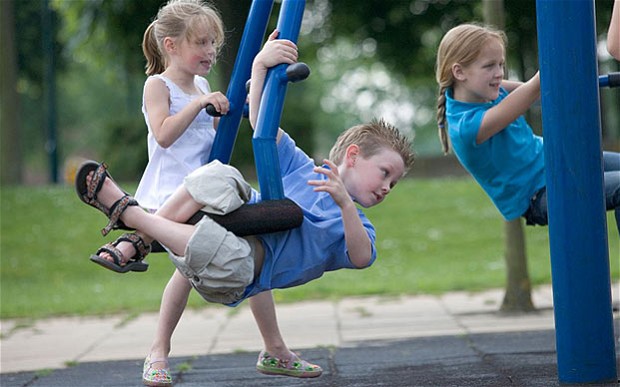Children could be at risk from lead in paint if they bite or suck play equipment, researchers warn
Paint on equipment in children’s playground contains up to 60 times the recommended levels of lead, scientists have discovered.
Environmental researchers from Plymouth University analysed the level of toxic metals used on climbing frames, swings, roundabouts and slides at 50 play parks in the south of England.
They found that even playgrounds that were less than a decade old had potentially dangerous levels of lead paint.
“The effects of lead on human health, including those that impact on the neurological development of children, are well-documented with regard to paint exposure in urban and domestic settings.” – Dr Andrew Turner, Plymouth University
Children are known to suck or bite down on play equipment, which risks lead poisoning, and UK guidelines say that paint used in such items can have just 2,500 lead parts per million.
However scientists at Plymouth found that paint with levels up to 152,000 parts per million were detected in railings, handles and gates.
Dr Andrew Turner, Reader in Environmental Science at Plymouth University, led the research. He said: “While undisturbed and intact, coatings and their chemical components are relatively safe.
“But once the film begins to deteriorate through abrasion or via exposure to UV light and moisture, the paint begins to crack, flake and chalk and metal-bearing particulates are mobilised into the environment.
“The effects of lead on human health, including those that impact on the neurological development of children, are well-documented with regard to paint exposure in urban and domestic settings.”
Lead poisoning can be lethal, but exposure can also cause a number of other complaints such as fatigue, headaches, cramps, vomiting, learning difficulties and developmental delay.
The researchers have called for councils to monitor parks more regularly to check that paint is not flaking or cracking.
They also say parents should be made aware of the dangers of children sucking or biting painted surfaces or accidentally eating paint chips.
And they have called for stricter controls to be applied to domestic and imported paints used for playgrounds.
Dr Turner added: “Given that the total tolerable daily intake of lead for a child under six years of age is 6 microgrammes, the results of this study suggest that very little ingestion is required to present a potential health hazard.
“And while our tests have focused on the south of England, there is no reason to suggest its results would not be replicated across the UK and further afield.
“It is difficult to attribute poisoning directly to paint on playground equipment because the effects of lead are cumulative and children may be exposed to a multitude of sources of lead in domestic and urban settings.
“But previous studies around elevated lead in blood levels and the ingestion of paint chips have strongly suggested that paint is the source of intoxication.”
The research was published in the journal Science of the Total Environment.
Source – The Telegraph


